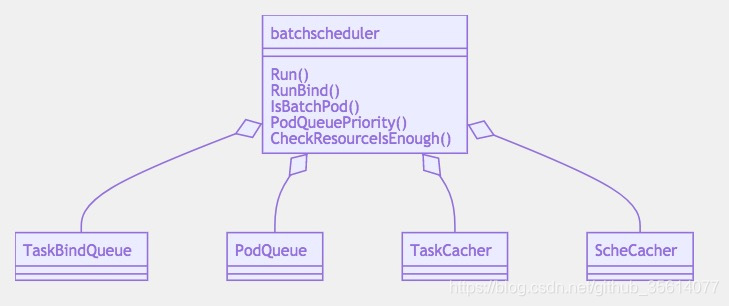什么是批处理任务
深度学习中经常会出现多机多卡的任务,也就是同事会起多个pod,但是这多个pod属于同一个任务。
这样就会有一个问题
一个任务要起100个pod,每个pod需要一张卡,总共需要100张GPU卡,而集群中只有99张空闲的GPU卡,这样默认的k8s调度器会如何处理?
因为默认调度器是一个一个pod调度的,只会检查单个pod资源够不够,这样前99个都能成功,最后一个pod调度失败。
这样非常有可能造成
- 任务跑不了
- 前99个占着GPU不释放,新的任务无法调度
- 严重时整个集群死锁,都“占着茅坑不拉屎”
所以需要在调度时对整个task所需所有资源进行检查,当集群总体资源不够时,一个pod都得不到调度。
社区提供了一个能支持这种特性的调度器
但是这个调度器是没办法和原生调度器很好的配合工作的
- 最大的问题在于两个调度器都有cache,这样cache的内容会冲突,导致调度混乱
- 这个调度器没法和原生调度器同时起作用,这样用了这个batch调度器后就没法用亲和性什么的特性了
所以我们做的事是将两者特性融合,选择的方法是定制化开发kube-scheduler
其实scheduler是可以通过extender扩展的,但是extender还是太弱了,它仅能在预选和优选过程中加入自己的过滤策略,而这对于批处理任务远远不够。
实现难点
需要优选时加batch任务检查
拿到一个pod ---> 如果是一个batchpod ---> 查询集群资源是否满足batch任务--->否调度失败需要保障batch任务中其它pod能得到调度
如果集群资源能满足这个batch任务直接去bind有个问题:
假设调度队列是这样,假设集群中有三个GPU,而batch任务需要三个GPU:
| A batch pod -> | pod -> | pod -> | A batch pod -> | A batch pod |
|---|---|---|---|---|
| 集群资源够 调度成功 | 调度了别的pod | 调度了别的pod | GPU被别的pod占用 GPU不够 失败 | GPU不够 失败 |
所以最终结果是A批任务占用了一个GPU但是整个任务是调度失败的,那一个GPU还得不到释放
所以需要修改pod调度队列里的顺序?让A batch pod连续调度? 没这么简单,
pod调度是创建协程并发调度的,这样即便去调整任务队列里pod的顺序也不一定能保证batch任务其它pod能得到优先调度。
go wait.Until(sched.scheduleOne, 0, sched.config.StopEverything)只要batch pod走到Bind逻辑了就没有回头路了
batch任务中所有pod先进行assume调度,其中任意一个失败就清理掉其它已经bind但是还没实际进行调度的pod。 并把所有pod扔回队列,或者直接返回调度失败清理改任务的pod,让上层重新触发?
scheduler流程 scheduler/sheduler.go scheduleOne逻辑:
选节点->cache assume pod on node-> 创建协程bind
所以在assume时去检查,不满足退还已经调度的pod是不可行的,因为之前batch任务中的pod可能已经bind过了, 所以只能batch任务中最后一个pod得到确认才能去bind前面的pod
预占用策略
预占用策略: 第一个batch pod任务来时,检查集群资源是不是够,如果够进行预占,把其它几个node打上标记,让接下来pod无法占用其它的node,这样batch任务其实pod过来就有节点可用。
回到了不能bind的问题。。。
这种问题有两点:
如何知道batch任务中其它pod需要什么样的节点,如果pod都一样问题可简化
如果后面的pod失败了,第一个pod还是已经bind,还是会出现一样的问题
最终还是在所有pod assume之前不能bind单个pod
综上,需要在几个地方处理
队列最好用优先级队列,把正在调度的pod的关联pod优先级提高
选节点时做判断,看集群资源是否够
选好节点assume pod时检查,如果自己不够或者pod组不够就不去bind
问题是之前的pod已经走了bind流程,所以最重要的是如何解决让之前的pod不去bind,延迟bind
最终方案 - 延迟绑定
方案:在batch任务bind时进行特殊处理
- 如果是batch任务扔进task cache,不进行binding
- 如果batch任务最后一个pod扔进task cache,该task ready,放进bind队列
- 在bind队列里取task 进行bind,task互斥锁与普通pod bind时互斥
使用
batch任务使用,pod增加两个注解:
annotations:
scheduling.k8s.io/group-name: qj-1
scheduling.k8s.io/group-pod-num: 3pod加上这两个注解表示属于同一个task, num表示task里有多少pod。
本来是再定义一个CRD去描述这个task,耦合会小一些,但是实现麻烦些,需要多监听一个CRD,偷懒就没这样做
实现
延迟绑定流程:
- 如果是普通的pod,找到节点后assume就直接bind
- 如果是批处理任务,直接扔到批处理缓存中返回
- 有个协程一直检查批缓存中是否有成功的task (pod都齐了)
- 成功的task扔进binding队列,worker取成功的task进行批量绑定,绑定时与普通pod互斥
batch scheduler接口与成员
Run 起一个协程检查成功的task并塞入队列
RunBind 起一个task绑定协程
PodQuePriority 去动态修改pod队列的优先级,让同task的pod优先调度
执行流程:
延迟绑定
scheduler/scheduler.go:
//fanux if it is a batch pod, return
if sched.Config.BatchScheduler.IsBatchPod(assumedPod) {
err = sched.Config.BatchScheduler.HandleBatchPod(assumedPod)
if err != nil {
glog.Errorf("schedule batch pod failed: %v", assumedPod.Namespace, assumedPod.Name)
}
return
}增加绑定互斥,防止batch任务和普通pod同事binding:
go func() {
//fanux add bind mutex
sched.Config.BatchScheduler.Lock()
defer sched.Config.BatchScheduler.UnLock()
err := sched.bind(assumedPod, &v1.Binding{检查资源是否充足CheckResourceIsEnough
should't use filterFunc, needs nodelist
scheduler/util/batch.go
package util
import "api/core/v1"
//CheckResourceIsEnough is
func CheckResourceIsEnough(pod *v1.Pod, nodes []*v1.Node) (bool, error) {
return false, nil
}scheduler/core/generic_scheduler.go
//fanux add checkBatchPodResource
flag, err := util.CheckResourceIsEnough(pod, filteredNodes)
if !flag || err != nil {
return "", err
}
trace.Step("Prioritizing")处理资源不足时的情况
suggestedHost, err := sched.schedule(pod)
//fanux add handle if resource not enough
if strings.Contains(err.Error(), common.BatchResourceNotEnough) {
sched.Config.BatchScheduler.HandleResourceNotEnough(pod)
} else if err != nil {如何获取节点已经分配GPU的数量
nodeInfo allocatableResource - requestedResource is avaliavle resource
requestedResource *Resource
nonzeroRequest *Resource
allocatableResource *ResourceGPU 是 ScalarResources, 资源名称叫 : NVIDIAGPUResourceName = "nvidia.com/gpu"
type Resource struct {
MilliCPU int64
Memory int64
EphemeralStorage int64
// We store allowedPodNumber (which is Node.Status.Allocatable.Pods().Value())
// explicitly as int, to avoid conversions and improve performance.
AllowedPodNumber int
// ScalarResources
ScalarResources map[v1.ResourceName]int64
}增加podupdater,可更新podcondition状态
batchScheduler := batch.NewBatchScheduler(c.schedulerCache, c.podQueue, &binder{c.client}, &podConditionUpdater{c.client})需要把batch scheduler的cache给generic_scheduler资源检查时需要用
需要知道已经有哪些pod已经assume过了,把这个数量减掉才是batch任务还需要多少GPU
core/generic_scheduler.go
//fanux add batch Cache
//check batch pod resource is enough need batch scheduler cache
BatchCache common.TaskCache //fanux add checkBatchPodResource
flag, err := common.CheckResourceIsEnough(pod, filteredNodes, g.cachedNodeInfoMap, g.BatchCache)factory.go
//fanux check batch resource is enough need batch scheduler cache
batchCache := batchScheduler.GetTaskCache()
algo := core.NewGenericScheduler(
...
batchCache,
)then checkresource :
//shoud not use metadata, need use metadata - assumed pod num in batch cache
_, podNum := GetPodBathMeta(pod)
podNum -= batchCache.GetTaskAssumedPodNum(pod)检查资源是否充足详细算法:
有很多细节
//获取pod需要多少GPU,这个需要把pod里容器配额加起来
func GetPodGPUCount(pod *v1.Pod) (count int) {
for _, c := range pod.Spec.Containers {
limit, ok := c.Resources.Limits[NVIDIAGPUResourceName]
l, okay := limit.AsInt64()
if !ok || !okay {
continue
}
count += int(l)
}
glog.Infof("Pod [%s] need GPU [%d]", pod.GetName(), count)
return
}
//获取节点空闲GPU,需要把可分配的减去已经申请的
func GetNodeFreeGPU(nodeInfo *cache.NodeInfo) int {
if nodeInfo == nil {
return 0
}
allocatable, ok := nodeInfo.AllocatableResource().ScalarResources[NVIDIAGPUResourceName]
if !ok {
glog.Errorf("can't fetch allocatable GPU : %v", nodeInfo)
return 0
}
glog.Infof("node [%s] allocatable GPU [%d]", nodeInfo.Node().Name, allocatable)
requested, ok := nodeInfo.RequestedResource().ScalarResources[NVIDIAGPUResourceName]
if !ok {
//glog.Errorf("can't fetch requested GPU : %v", nodeInfo)
//return 0
requested = 0
}
glog.Infof("node [%s] requested GPU [%d]", nodeInfo.Node().Name, requested)
available := allocatable - requested
glog.Infof("available node [%s] GPU : [%d]", nodeInfo.Node().Name, available)
return int(available)
}
//这里最关键的点是需要把annotations里面获取的task pod总数减去已经assume过的batch pod,这样才是真实所需
func CheckResourceIsEnough(pod *v1.Pod, nodes []*v1.Node, cachedNodeInfoMap map[string]*cache.NodeInfo, batchCache TaskCache) (bool, error) {
//if is not batch pod, return true,nil
if !IsBatch(pod) {
glog.Infof("pod %s is not batch pod", pod.GetName())
return true, nil
}
//shoud not use metadata, need use metadata - ready pod num in batch cache
_, podNum := GetPodBathMeta(pod)
podNum -= batchCache.GetTaskAssumedPodNum(pod)
everyPodNeedsGPU := GetPodGPUCount(pod)
if everyPodNeedsGPU == 0 {
glog.Infof("pod %s require 0 GPU", pod.GetName())
return true, nil
}
// TODO maybe check nodes[1:], node[0] already allocate a pod, CPU and other metric may reach limit
for _, node := range nodes {
nodeInfo, ok := cachedNodeInfoMap[node.Name]
if !ok {
continue
}
nodeFree := GetNodeFreeGPU(nodeInfo)
podNum -= nodeFree / everyPodNeedsGPU
glog.Infof("pod: [%s] node: [%s] podNum [%d] nodeFree [%d] podNeed [%d]", pod.GetName(), node.Name, podNum, nodeFree, everyPodNeedsGPU)
if podNum <= 0 {
return true, nil
}
}
return false, fmt.Errorf("BatchResourceNotEnough : pod name is %s", pod.GetName())
}
//判断是不是batch pod
func IsBatch(pod *v1.Pod) bool {
g, n := GetPodBathMeta(pod)
if g == "" || n == 0 {
glog.Infof("The pod's group name is empty string,pod name is %v.", pod.GetName())
return false
}
return true
}关于GPU的使用与发现
这里包含docker nv-docker GPU-device plugin
install.sh...
/etc/docker/daemon.json
[root@compute-gpu006 ~]# cat /etc/docker/daemon.json
{
"default-runtime":"nvidia",
"runtimes": {
"nvidia": {
"path": "/usr/bin/nvidia-container-runtime",
"runtimeArgs": []
}
}
}kubectl describe node xxx:
Capacity:
cpu: 72
ephemeral-storage: 222779Mi
hugepages-1Gi: 0
hugepages-2Mi: 2Gi
memory: 791014684Ki
nvidia.com/gpu: 2 # 这里就能看到GPU了
pods: 110
Allocatable:
cpu: 72
ephemeral-storage: 210240641086
hugepages-1Gi: 0
hugepages-2Mi: 2Gi
memory: 788815132Ki
nvidia.com/gpu: 2
pods: 110总结
原生调度器的设计就是pod one by one,所以做这个功能的开发还是改动非常大的,也是比较困难的,工作量不大,但是需要找到一个优雅的方案,
合理的架构比较麻烦,想了很久做了这个侵入不太大的实现方案,欢迎大家一起讨论
公众号:
